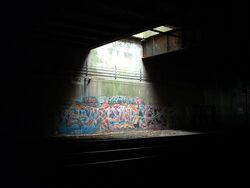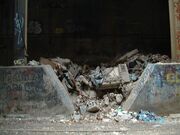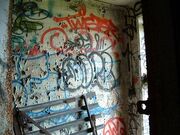
Most artwork is centered under the light

Demolished shantytowns

The tunnel is not completely dark. Exits at many points let in light and noise from the nearby playgrounds and parks
The Freedom Tunnel is the name given to the Amtrak tunnel under Riverside Park in Manhattan, New York City. It got its name because the graffiti artist Chris "Freedom" Pape used the tunnel walls to create some of his most notable artwork. The name may also be a reference to the former shantytowns built within the tunnel by homeless populations seeking shelter and freedom to live rent-free and unsupervised by law enforcement.
History[]
The tunnel was built by Robert Moses in the 1930s to expand park space for Upper West Side residents – although Moses's expansion of freeways in the same area effectively blocked access to the river.
After it was completed, the train tunnel was not used for long. With the automobile and trucking taking over more of the city's transport needs, trains no longer ran along the West Side, and the giant, man-made caverns became a haven for homeless people. At its height, hundreds of people lived in the tunnel. On April 4, 1991, the tunnel was reopened as the Amtrak Empire Connection for trains and a massive eviction followed. The shantytowns were bulldozed and the tunnel was chained off.
To this day, however, graffiti artists and urban explorers continue to visit the tunnel, while the homeless population has dwindled to almost zero.
Artwork[]
Over the tunnel's years of disuse, its isolated nature allowed graffiti artists and street artists to work without fear of arrest, leading to larger and more ambitious pieces. The tunnel has unique lighting provided by grates in the sidewalks of Riverside Park. The shafts of light allow graffiti art to be seen in the gloom, and artists would often center their projects under the light to take advantage of the spot-lighting effect, as if in a gallery.
After achieving popularity in the book Spraycan art by James Prigoff and Henry Chalfant, graffiti artists began to flock to the Freedom Tunnel and gained access through a series of broken gates near 103rd street and Riverside Park. Early artists who left their mark on the tunnel included Smith and his brother Sane (who died in 1991), Ghost, Twist, Cost, and Revs.
Until the construction of the Trump Riverside development, the south side of the tunnel ended with a large open area. In the 1980s and 90s, a tent city with pirated electricity and hundreds, perhaps thousands of dwellers existed in the south end of the tunnel. Retired trains were also permanently parked near the south end of the tunnel allowing artists to cover whole cars with paint and murals, even if the cars themselves never left the tunnels.
Works by "Freedom" remained mostly untouched and respected by taggers. A notable exception was the recreation of Goya's "The Third of May," which was defaced, but subsequently restored by Freedom. In addition to the "Third of May," there are numerous other murals on the walls in the 100 and 90 block areas of the tunnel; including a chiaroscuro style study of the Venus de Milo, and original portraits rendered with impressionistic splashes of color. The centerpiece of the tunnel is a mural painted in the style of a comic book that tells an abstract story that seems to reference the relationship of the former residents of the tunnel, the city, and the police.
Beginning on the fall of 2009, Amtrak began to aggressively repaint the tunnels in an effort to restore their original appearance. Nearly all of the tunnel's interior walls have been repainted, resulting in most murals disappearing, including the centerpiece mural by Freedom and Smith commemorating the former residents of the tunnel.
The "Third of May" mural has recently suffered a great deal of water damage due to a leak in the tunnel directly above.
Film: Dark Days[]
British filmmaker Marc Singer spent two years underground shooting the film Dark Days, a documentary about the inhabitants of the Amtrak tunnel network.
Links[]
See Also[]
| This page uses Creative Commons Licensed content from Wikipedia (view authors). |
